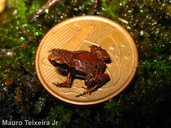|
Brachycephalus hermogenesi (Giaretta & Sawaya, 1998)
| family: Brachycephalidae genus: Brachycephalus |
 © 2008 Mauro Teixeira Jr (1 of 4) |
|
|
|
Description In life, this small frog is brownish yellow or palebrown on the dorsum. The dorsal surface of the thigh may show a pale pink pattern. 40% of preserved specimens display narrow stripes that form a dark X on the dorsum. Some individuals have large symmetrically paired dark spots on the dorsum and/or sacrum region. Some have the dorsum of the limbs crossed with a gray stripe. A narrow vertebral stripe may be present, and in some specimens, lateral coloration is darker than dorsum. Ventral surfaces are pale gray with many brown spots. Belly has many intersperced glandular areas on a uniformly dark with white spotted background. Its close relative, B. didactylus, differs by having its glands concentrated onto one belly area and thus creating a black spot. The head is wider than it is long, and in dorsal view the snout is rounded. Nostrils closer to tip of snout than to the eyes. Tympanum indistinct but visible. Anterior border of nostrils and inferior border of eys are grooved. First and fourth fingers vestigial, third larger than second. First toe is absent and the second is larger than fith and smaller than third. Skin is smooth or slightly granular on upper eyelid and nostril. Osterodermal plate on the body is absent (found in the sister genus Brachycephalus). The presence of a functional 5th toe in this species is unique within not only this genus, but also in other diminutive frogs of the genus Brachycephalus and Euparkarella (Lynch 1971). Distribution and Habitat Country distribution from AmphibiaWeb's database: Brazil
Life History, Abundance, Activity, and Special Behaviors Possible reasons for amphibian decline General habitat alteration and loss Comments IUCN Red List's assessment of this species is Least Concern; however, Bornschein et al (2019) analysed the Brachycephalus species using the IUCN Red List criteria with newer information and concluded this species as Vulnerable, based on its limited known range and ongoing habitat loss.
References
Bornschein, M. R., Pie, M. R., Teixeira, L. (2019). "Conservation status of Brachycephalus toadlets (Anura: Brachycephalidae) from the Brazilian Atlantic rainforest.” Diversity, 11(150), 1-29. doi: 10.3390/d11090150 [link]
Giaretta, A. A., and Sawaya, R. J. (1998). ''Second species of Psyllophryne (Anura: Brachycephalidae).'' Copeia, 1998(4), 985-987.
Kaplan, M (2002). "Histology of the anteroventral part of the breast-shoulder apparatus of Brachycephalus ephippium (Brachycephalidae) with comments on the validity of the genus Psyllophryne (Bracycephalidae)." Amphibia-Reptilia, 23, 225–227.
Lynch, J. D. (1971). ''Evolutionary relationship, osteology, and zoogeography of leptodactyloid frogs.'' Occasional Papers of the Museum of Natural History, University of Kansas, 53, 1-238.
Species Account Citation: AmphibiaWeb 2022 Brachycephalus hermogenesi <https://amphibiaweb.org/species/5514> University of California, Berkeley, CA, USA. Accessed May 8, 2025.
Citation: AmphibiaWeb. 2025. <https://amphibiaweb.org> University of California, Berkeley, CA, USA. Accessed 8 May 2025.
AmphibiaWeb's policy on data use.
|


 Map of Life
Map of Life